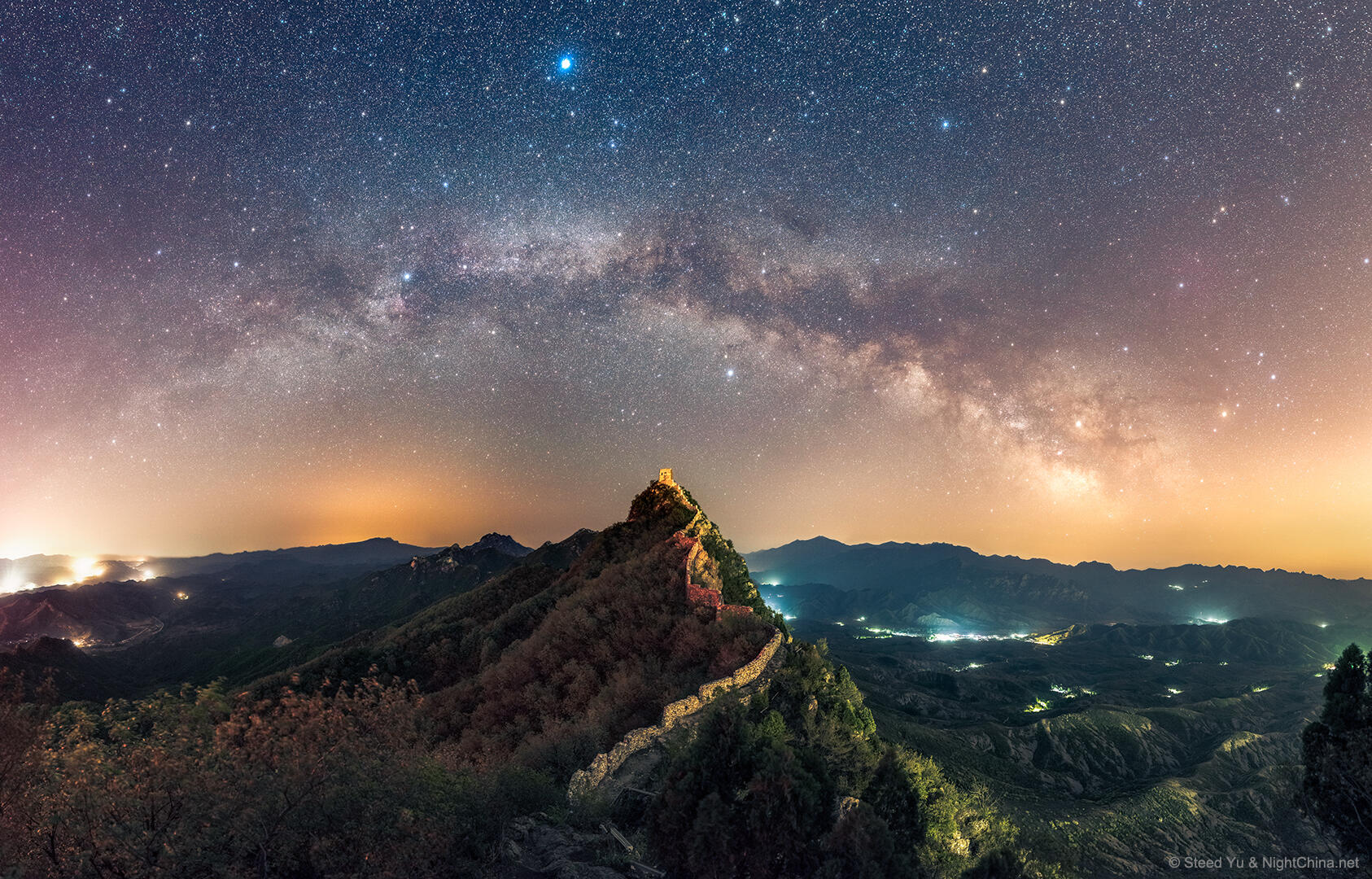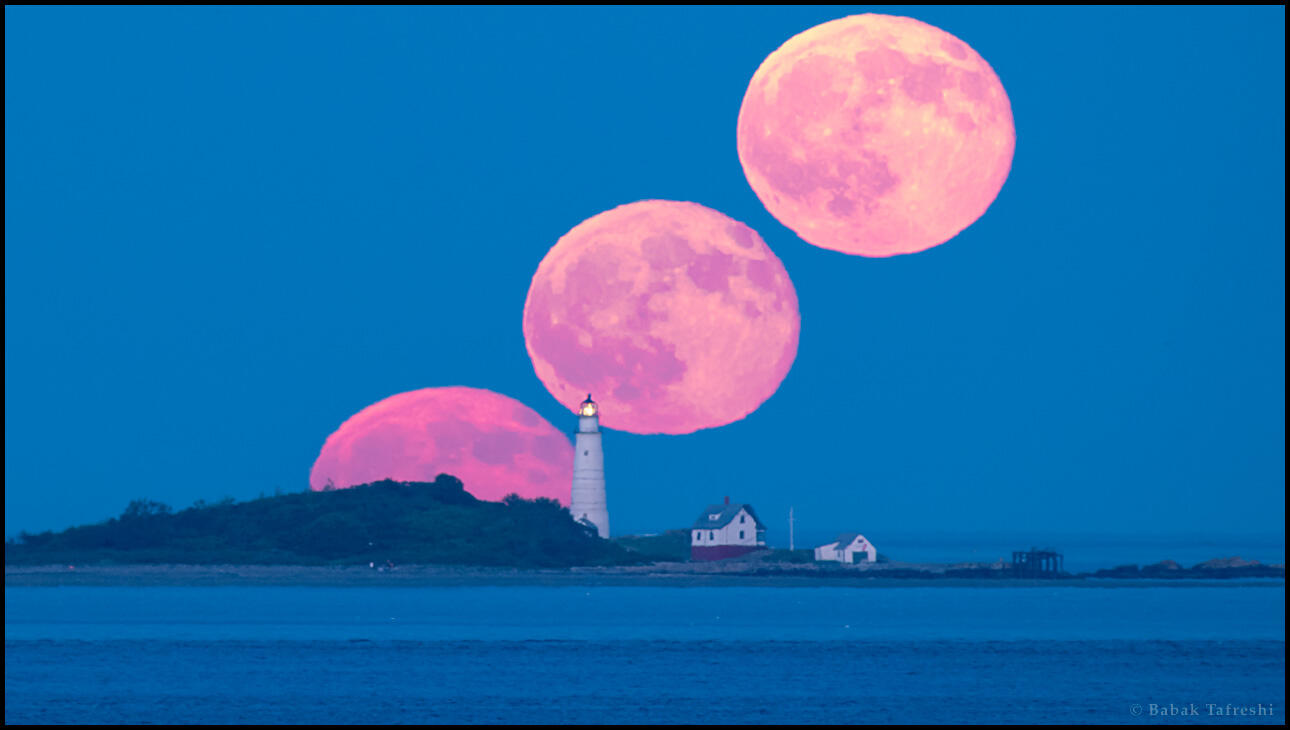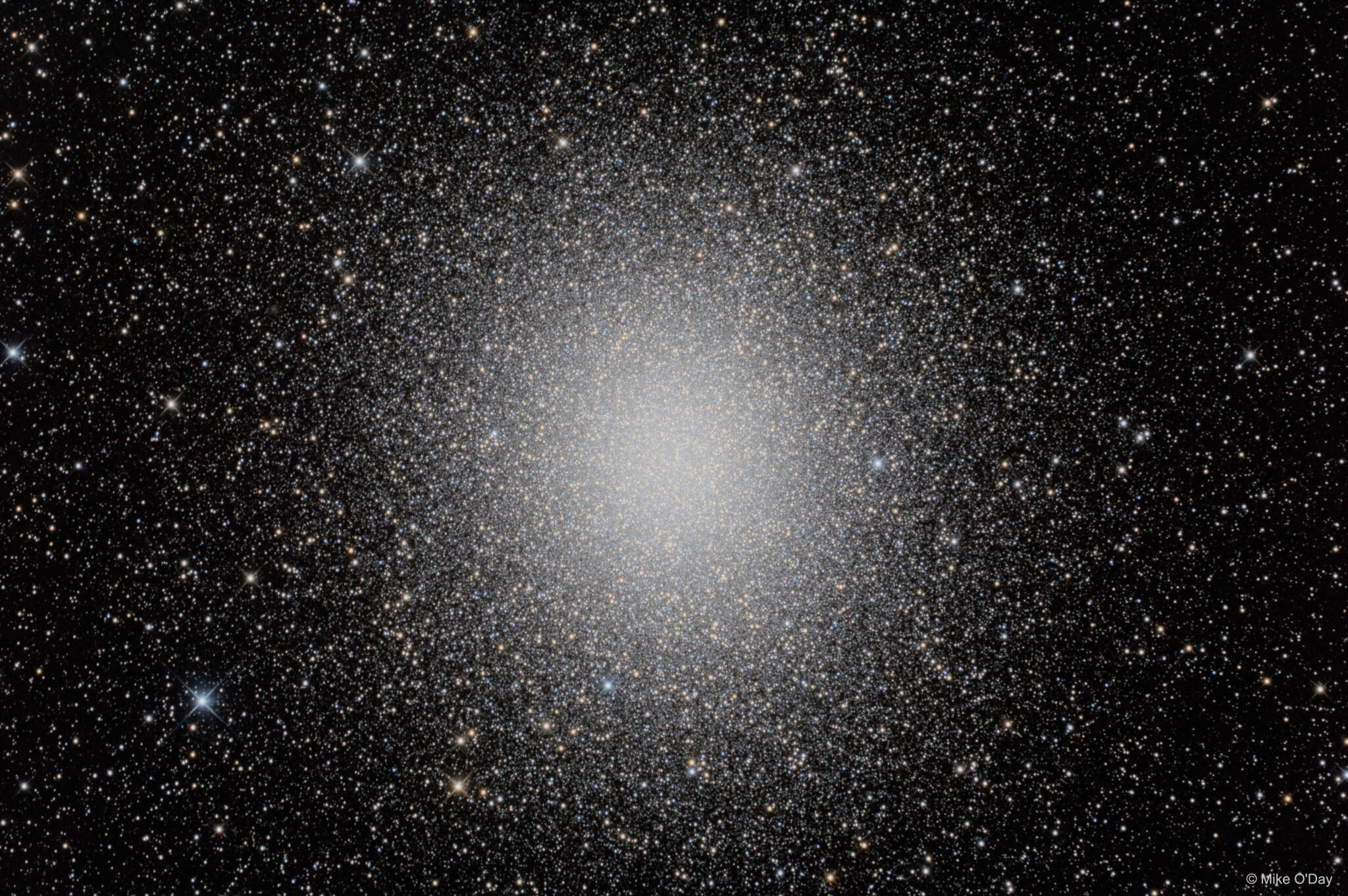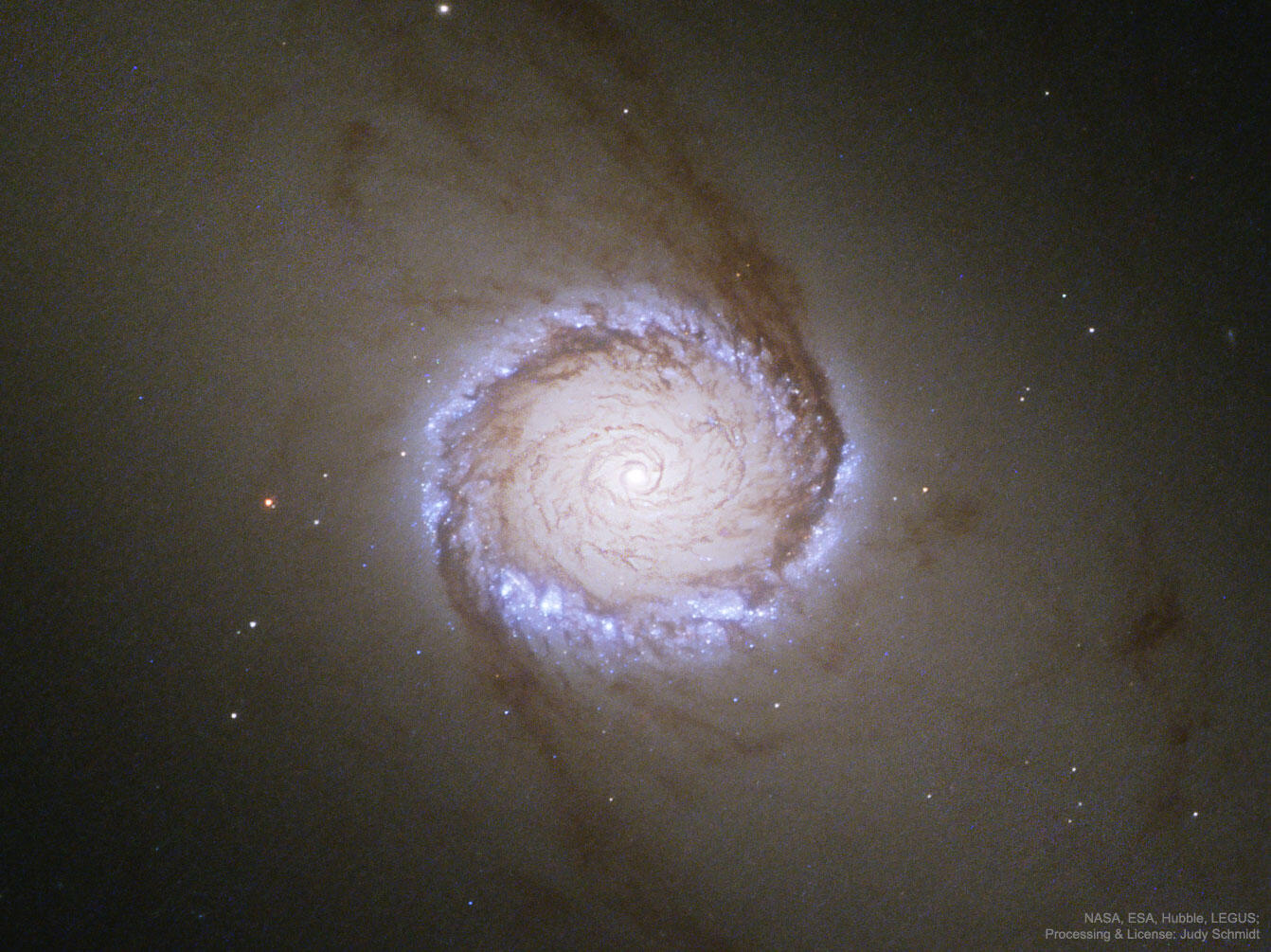Astronomy Picture of the Day

The beautiful Trifid Nebula, also known as Messier 20, lies about 5,000 light-years away, a colorful study in cosmic contrasts. It shares this nearly 1 degree wide field with open star cluster Messier 21 (top left). Trisected by dust lanes the Trifid itself is about 40 light-years across and a mere 300,000 years old. That makes it one of the youngest star forming regions in our sky, with newborn and embryonic stars embedded in its natal dust and gas clouds. Estimates of the distance to open star cluster M21 are similar to M20's, but though they share this gorgeous telescopic skyscape there is no apparent connection between the two. M21's stars are much older, about 8 million years old. M20 and M21 are easy to find with even a small telescope in the nebula rich constellation Sagittarius. In fact, this well-composed scene is a composite from two different telescopes. Using narrowband data it blends a high resolution image of M20 with a wider field image extending to M21. Image Credit & Copyright: Martin Pugh

Have you ever seen the Summer Triangle? The bright stars Vega, Deneb, and Altair form a large triangle on the sky that can be seen rising in the northern spring during the morning, and rising in the northern fall during the evening. During summer months, the triangle can be found nearly overhead near midnight as three of the brightest stars on the sky. Featured here, along with the arch of the central band of our Milky Way Galaxy, the Summer Triangle asterism was captured this spring over the Great Wall of China. This part of the Great Wall, a World Culture Heritage Site, was built during the 6th century on the Yan Mountains. At the summit is Wangjinglou Tower from which, on a clear night, the lights of Beijing are visible in the distance. Image Credit & Copyright: Steed Yu & NightChina.net

What's wrong with this picture? If you figure it out, you may then realize where the image was taken. The oddity lies actually in one of the buildings -- it leans. The Leaning Tower of Pisa has been an iconic legend since shortly after its construction began in the year 1173. Now part of a UNESCO World Heritage Site, folklore holds that Galileo used the leaning tower to dramatically demonstrate the gravitational principle that objects of different mass fall the same. Between the Leaning Tower of Pisa on the right and Pisa Cathedral and the Pisa Baptistery on the left, a full "Thunder" moon was visible last week when the image composite was taken. Using modern analyses, the tower has been successfully stabilized and, barring the unexpected, should hold its present tilt for the next 200 years. Image Credit & Copyright: Marco Meniero.

Thunderstorms almost spoiled this view of the spectacular 2011 June 15 total lunar eclipse. Instead, storm clouds parted for 10 minutes during the total eclipse phase and lightning bolts contributed to the dramatic sky. Captured with a 30-second exposure the scene also inspired one of the more memorable titles (thanks to the astrophotographer) in APOD's now 22-year history. Of course, the lightning reference clearly makes sense, and the shadow play of the dark lunar eclipse was widely viewed across planet Earth in Europe, Africa, Asia, and Australia. The picture itself, however, was shot from the Greek island of Ikaria at Pezi. That area is known as "the planet of the goats" because of the rough terrain and strange looking rocks. Image Credit & Copyright: Chris Kotsiopoulos (GreekSky)

This well-planned telephoto timelapse captures July's Full Moon rise across outer Boston Harbor, Massachusetts, planet Earth. In the foreground, the historic terrestrial beacon is known as Boston Light. July's Full Moon is known to some as a Thunder Moon, likely a reference to the sounds of the northern summer month's typically stormy weather. But the eastern sky was clear for this video sequence. Near the horizon, the long sight-line through atmospheric layers filters and refracts the moonlight, causing the rising Moon's reddened color, ragged edges and distorted shape. Image Credit & Copyright: Babak Tafreshi (TWAN)

A bright spiral galaxy of the northern sky, Messier 63 is about 25 million light-years distant in the loyal constellation Canes Venatici. Also cataloged as NGC 5055, the majestic island universe is nearly 100,000 light-years across. That's about the size of our own Milky Way Galaxy. Known by the popular moniker, The Sunflower Galaxy, M63 sports a bright yellowish core in this sharp composite image from space- and ground-based telescopes. Its sweeping blue spiral arms are streaked with cosmic dust lanes and dotted with pink star forming regions. A dominant member of a known galaxy group, M63 has faint, extended features that are likely star streams from tidally disrupted satellite galaxies. M63 shines across the electromagnetic spectrum and is thought to have undergone bursts of intense star formation. Image Credit & Copyright: Data - Hubble Legacy Archive, Subaru Telescope (NAOJ), Don Goldman. Processing - Robert Gendler, Roberto Colombari, Don Goldman.

Behold the largest ball of stars in our galaxy. Omega Centauri is packed with about 10 million stars, many older than our Sun and packed within a volume of only about 150 light-years in diameter. The star cluster is the largest and brightest of 200 or so known globular clusters that roam the halo of our Milky Way galaxy. Though most star clusters consist of stars with the same age and composition, the enigmatic Omega Cen exhibits the presence of different stellar populations with a spread of ages and chemical abundances. In fact, Omega Cen may be the remnant core of a small galaxy merging with the Milky Way. The featured image shows so many stars because it merged different exposures with high dynamic range (HDR) techniques. Omega Centauri, also known as NGC 5139, lies about 15,000 light-years away toward the southern constellation of the Centaurus. Image Credit & Copyright: Mike O'Day

What's happening around the center of this spiral galaxy? Seen in total, NGC 1512 appears to be a barred spiral galaxy -- a type of spiral that has a straight bar of stars across its center. This bar crosses an inner ring, though, a ring not seen as it surrounds the pictured region. Featured in this Hubble Space Telescope image is a "nuclear ring" -- one that surrounds the nucleus of the spiral. The two rings are connected not only by a bar of bright stars but by dark lanes of dust. Inside of this nuclearring, dust continues to spiral right into the very center -- possibly the location of a large black hole. The rings are bright with newly formed stars. Image Credit: NASA, ESA, Hubble, LEGUS; Acknowledgement: Judy Schmidt

Can you find your favorite country or city? Surprisingly, on this world-wide nightscape, city lights make this task quite possible. Human-made lights highlight particularly developed or populated areas of the Earth's surface, including the seaboards of Europe, the eastern United States, and Japan. Many large cities are located near rivers or oceans so that they can exchange goods cheaply by boat. Particularly dark areas include the central parts of South America, Africa, Asia, and Australia. The featured composite was created from images that were collected during cloud-free periods in April and October 2012 by the Suomi-NPP satellite, from a polar orbit about 824 kilometers above the surface, using its Visible Infrared Imaging Radiometer Suite (VIIRS). Image Credit : NASA, NOAA NGDC, Suomi-NPP, Earth Observatory, Data and Processing: Chris Elvidge and Robert Simmon.

Similar in size to large, bright spiral galaxies in our neighborhood, IC 342 is a mere 10 million light-years distant in the long-necked, northern constellation Camelopardalis. A sprawling island universe, IC 342 would otherwise be a prominent galaxy in our night sky, but it is hidden from clear view and only glimpsed through the veil of stars, gas and dust clouds along the plane of our own Milky Way galaxy. Even though IC 342's light is dimmed by intervening cosmic clouds, this sharp telescopic image traces the galaxy's own obscuring dust, blue star clusters, and glowing pink star forming regions along spiral arms that wind far from the galaxy's core. IC 342 may have undergone a recent burst of star formation activity and is close enough to have gravitationally influenced the evolution of the local group of galaxies and the Milky Way. Credit & Copyright: T. Rector (U. Alaska Anchorage), H. Schweiker, WIYN, NOAO, AURA, NSF.


No comments yet.